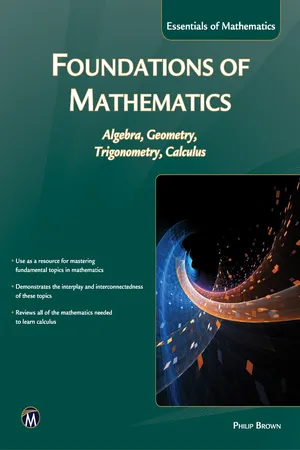Mathematics
Verifying Trigonometric Identities
Verifying trigonometric identities involves proving that one side of a trigonometric equation is equal to the other side. This is typically done by manipulating the expressions using trigonometric identities, algebraic techniques, and properties of trigonometric functions. The goal is to show that both sides of the equation are equivalent, thus verifying the identity.
Written by Perlego with AI-assistance
Related key terms
Related key terms
1 of 4
Related key terms
1 of 3
3 Key excerpts on "Verifying Trigonometric Identities"
- eBook - ePub
- Boris Pritsker(Author)
- 2019(Publication Date)
- Dover Publications(Publisher)
Chapter 6 Trigonometric Identities Trigonometric identities in problem solvingGreek words trigonon —“triangle” and metron —“measure” form the name “trigonometry,” one of the branches of mathematics, which historically originated from applications of geometry to astronomical calculations and studies. The ancient Greek mathematician and astronomer Hipparchus of Nicaea (c. 190–c. 120 BC) is regarded as the father of trigonometry. He was credited with the calculation and construction of the first trigonometric tables used in various astronomical computations. Starting from the studies of relationships involving lengths of the sides and angle measures in right triangles, mostly utilized in astronomy and navigation during ancient times, trigonometry eventually grew into a separate branch of mathematics. It is involved in various calculations and applications, not just in pure mathematics, but in such fields as physics, land surveying and geodesy, engineering, astronomy, music theory, acoustics, optics, chemistry, cryptology, architecture, computer graphics, meteorology, biology, and even ecology. The list can be endless, as it is hard to imagine any scientific research not utilizing trigonometric applications in one way or another.There is a common perception though among high school students about trigonometric functions as being used in geometry only to relate the angles of a triangle to its sides. For many their application of those functions is restricted to the calculation of the elements of a right triangle. There is not much time devoted to the study of trigonometric functions and trigonometric equations in the high school curriculum. In this and the next chapter we will try to fill that hole to some degree and offer an insight into the application of trigonometric functions in algebra, demonstrate various techniques for solving trigonometric equations, and give their connections to other topics covered throughout the book. - eBook - ePub
Foundations of Mathematics
Algebra, Geometry, Trigonometry and Calculus
- Philip Brown(Author)
- 2016(Publication Date)
- Mercury Learning and Information(Publisher)
In trigonometry, we use known identities to prove or verify more identities. The usual technique for doing this is to denote the left-hand side of the unproven identity as LHS and the right-hand side as RHS. One of the sides, either LHS or RHS, is then restated and manipulated by means of known identities and algebraic methods until it is shown to be equivalent to the other side. Alternatively, both sides can be restated and manipulated until it can be shown that they are both equivalent to some (new) expression. In the following example, each line is a restatement of the previous line by the means explained to the right of each line.EXAMPLE 4.9.1. Verify the identity: tan(θ) + cot(θ) = sec2 (θ)cot(θ).Answer:The next example is an application of FOIL (see section 1.8.1 ).EXAMPLE 4.9.2. Verify the identity: (sin(θ) − cos(θ))(csc(θ) + sec(θ)) = tan(θ) − cot(θ)Answer:4.10SOLVING BASIC TRIGONOMETRIC EQUATIONS
Solving trigonometric equations is dealt with in chapter 6 ; however, here we consider the following basic problem:EXAMPLE 4.10.1. Solve for x [0, 2π] in the equation 2sin(x) = 1.Answer: Solving for x means finding the value (or values) for x in the interval for which the equation is a true statement, that is, the values of x ∈ [0, 2π] for which From an examination of the graphs of and sin(x) on the interval [0, 2π] in figure 4.27 , we observe that there are exactly two values of x where the graphs intersect. These values are labeled x1 and x2 and occur in the first and second quadrants, respectively, that is,The values for x1 and x2 can be read directly from the unit circle (figure 4.11 ), that is, and because, for these values of the angle, the second coordinate of the corresponding reference point on the unit circle is .FIGURE 4.27. Solving a trigonometric equation.EXAMPLE 4.10.2. Solve for θ in the equation tan2 (θ) = 1, for θ ∈ [0, 2π].Answer: The problem is equivalent to solving two separate equations: tan(θ) = 1 and tan(θ) = −1, for θ ∈ [0, 2π]. The first equation is true for the two values and the second equation is true for the two values These values can be obtained by means of the graphical method we used for the problem above. Thus, the original equation tan2 (θ) = 1 has the four given solutions θ1 , θ2 , θ3 , and θ4 , in the interval [0, 2π].EXAMPLE 4.10.3. Find the general solution of the equation - eBook - ePub
The Ellipse
A Historical and Mathematical Journey
- Arthur Mazer(Author)
- 2011(Publication Date)
- Wiley(Publisher)
This section presents several trigonometric identities. The identities are later used to extend the trigonometric table.5.4.1 Pythagorean IdentityApplying the Pythagorean theorem to any values of x and y on the unit circle results in the following equality:Replacing x and y by their trigonometric values yields the following identity:A notational convention has been used. More commonly [cos(θ )]2 is written as cos2 (θ ). Similarly, [sin(θ )]2 is more commonly written as sin2 (θ ).5.4.2 Negative of an AngleFrom the definitions of the trigonometric functions and Figure 5.6 , it is readily seen that the following equalities hold:Note the use of these equalities in Example 5.4 where the trigonometric functions were extended to other quadrants. 5.4.3 Tan(θ ) in Terms of Sin(θ ) and Cos(θ ) Also, from the definitions of the trigonometric functions, the following holds:5.4.4 Sines and Cosines of Sums of AnglesLet two angles α and β be given. As illustrated in Figure 5.11 , let (xα,yα) be the point on the unit circle aligned with angle α and (xα +β, yα +β) be the point on the unit circle aligned with the angle α +β . Note that the point (xα +β, yα +βis a rotation of the point (xα,yα) by the angle β .Figure 5.11 Trigonometric functions of the angle α + βUsing the rotation matrixMβ, the point (xα +β, yα +β) can be expressed in terms of the point (xα,yα):Substituting for xα +βand yα +βresults in the following two summation identities:5.4.5 Difference FormulasUsing the negative-angle formulas of Section 5.4.2 in the summation identities of Section 5.4.4 results in the difference formulas5.4.6 Double-Angle FormulasSetting β equal to α
Index pages curate the most relevant extracts from our library of academic textbooks. They’ve been created using an in-house natural language model (NLM), each adding context and meaning to key research topics.
Explore more topic indexes
Explore more topic indexes
1 of 6
Explore more topic indexes
1 of 4


